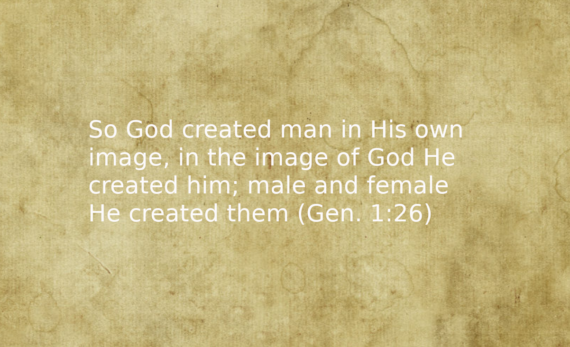In 1980 Francis Shaeffer and J. P. Moreland published a book entitled “He Is There and He Is Not Silent”. The title of that work suggested something profound about the existence of God and his self-disclosure.
There are of course, many things about God and his ways that he has chosen not to reveal. But God has not been silent about gender roles. His actions have been recorded, his commands have been preserved and at least some of his reasons have been revealed. Taken together, these move us toward a theology of gender roles.
We begin this discussion by noting that the bible as a whole treats the Genesis account of creation as an historical record. It is neither myth nor metaphor. Luke’s genealogy traces the ancestry of Jesus back to the first man Adam who was not an imaginary figure.




One can scarcely begin to read the bible before coming to the creation of Man. The scriptures affirm that God created a single humanity, composed of two people with two distinct genders each of whom was made in the image of God. Genesis chapter two expands this story, explaining that God made the man first and then made the woman from a body-part of the man (Genesis 2, 1st Tim. 2:13). Once created, the woman was brought to the man and presented to him as a companion and a wife. Adam called her ‘woman’ for she was taken from man (Gen. 2).
Now when we first read this, there do not appear to be any self-evident conclusions. The bare facts do not really speak for themselves. The theological significance of the order of creation emerges only as we read further. It becomes quickly apparent that Adam is in charge. By giving her a name, Adam relates from a position of leadership and headship. God reinforced that headship by making what had been implicit, explicit, reminding Eve that despite her desire to the contrary, her husband would rule over her (Gen. 3:16).
The apostle Paul explained the significance of the creation order by stating that the man is the head of the woman, for the man was not made for the woman but the woman for the man. For the man was not made from the woman but the woman from the man (1st Cor. 11:3, 9). God gave Adam authority over his wife and that aspect of the husband-wife relationship remains in place.( Eph. 5:23 1st Pet. 3:1)
What Paul means to say is that God did this deliberately. It did not happen because He was inattentive or somehow distracted. God did precisely what he set out to do. He created a single humanity made up of two separate people, two distinct genders for which he had in mind two distinctly separate roles. He signaled this by creating one first and then the other.
The Old Testament consistently reflects this headship in the covenants and ordinances of God. Men were called to act as the head of their families and to lead in spiritual matters.
This arrangement persists as we enter the New Testament. When God came to earth in human form, he came as a man. When Jesus chose those who would lay the foundation for the church he chose twelve men from among his disciples to serve as apostles. (Matt. 10:1-4, Luke 6:12-16, Mark 3:13-18). When the apostles organized the church according to the will of Jesus, they appointed men to serve as evangelists, elders, deacons and teachers. When the gospel came to the egalitarian culture of Greece, the apostle Paul reminded the Corinthian church about the headship of the man and the distinct leadership roles given to men and not to women. (1st Cor. 11:1-17, 14:34-40). He repeated these instructions to Timothy, serving in a very different culture in Asia. (1st Tim. 2:8-15) The roles that Paul identified applied equally to the church in each and every culture of the ancient world. (1st Cor. 11:16)1. Paul makes it clear that distinct gender roles find their source and parallel in the makeup of the godhead and in God’s plan for our salvation. (1st Cor.11:3)
The fact is that the order of God’s creation cannot be undone. Nor can the theological significance of this creation-order be removed from scripture. To do so does great violence to the Biblical doctrine of Man and even greater violence to the doctrine of the Godhead.
The scriptures teach that there is one and only one God. They further affirm that there are three members of the godhead. These are identified for us as the Father, the Son and the Holy Spirit. All are equally God. All are equal in essence and being. Theirs’ is a shared divinity whose sum is; one God.
What emerges within scripture as further revelation about God is that the persons of the godhead have voluntarily assumed distinct and separate roles. These roles predate creation and remain beyond The Judgment. They act as bookends for our existence2.
There are three prominent features attending these divine roles.
- The first is organizational. The godhead functions as a hierarchy. God the Father has had authority over God the Son and God the Holy Spirit. Thus, the father sent the Son to be the savior of the world. And God the Father sent the Holy Spirit to empower the Son and to indwell His people. The Son in turn sends the Holy Spirit to dwell within and to be with his people. Though equally divine, these three do not act – for the present – from a position of equal authority.
- The second thing about these roles is that they have been voluntarily entered into. Jesus agreed to the incarnation. He agreed to submit to the Father while on earth.
- There is every indication that these roles are not interchangeable. God the Father has at no time ever been the Son or fulfilled the role of the Son. In Gethsemane, the Son did not implore the Father to change places with him. All three persons of the godhead have been true to their roles no matter the cost.
It is reasonable therefore to conclude, that at the very core – at the very essence of the being of God, there is a nature of humility and condescension. No one could have suspected it. There is no apparent reason why God should be humble. Nor can we conceive why it could ever be right for God to submit. What we learn from the godhead is a unique truth about God that is found nowhere else.
While the doctrine of the godhead is 2000 years old, it is hard to find anyone marching in the streets, demanding equal rights for the Son. The theological form that this protest is taking is to deny the doctrine of the godhead altogether. After all, one cannot reasonably worship a god of submission and humility while promoting ‘egalitarianism’. What is truly alarming is that this denial has even surfaced within the churches of Christ.
The bible teaches, that what God is in his essence and in the godhead, is reflected in creation. There is only one God and only a single humanity. But being made in the image of God also suggests that mankind must reflect the truth about the godhead. To that end, God has made a distinction between men and women from the very beginning, giving to each a uniquely separate role. He served notice of this by creating one first and then the other. Like the roles of the godhead, human roles cannot be exchanged. They are God’s doing and not our own.
Denying that such roles exist denies the essential truth about God. It disowns the God who in three persons created the world. It is ashamed of the God who from eternity purposed to save us from sin by taking upon himself our humanity. And it renounces the God who condescends to dwell within us, sent by both the Father and Son. The great irony is that God is willing to do what we are not.
Should the church renounce these roles it will cease to reflect the true nature of the godhead. The writers of the New Testament knew this and made it very clear that in God’s new creation, the roles of men and women have not changed.
We are very much aware that the world is watching us. The great danger is that we will be embarrassed by the gospel of Jesus Christ and decide to preach another. The great privilege remains for us to conform to the image of God himself, honoring him from within the roles that He has given.
This alone puts the wisdom of God on display. It elevates God’s will above our own and invites the world to ask why? To which we must reply “I’m glad you asked; let me tell you about my God”.
1 These roles should therefore never be confused with or compared to those things that human beings have put in place within culture. God created Mankind (male & female) in his own image. Male and female he created them. He did not create women with veils on nor did he create some men as masters or others as slaves. The presence or absence of these human practices has no bearing on the subject of God-given roles for men and women.
2 The Apostle Paul states that all (created) things are from God the father for whom we exist and all things are through our Lord Jesus Christ, through whom we exist (1st Cor. 8:6). John expresses this same distinction between the roles of God (the Father) and the Word (the Son) in John 1:1-3. The separate roles of Father and Son predate creation. 1st Corinthians 15:28 explains that at the end of time, “The Son himself will be subjected to him who put all things under him, that God may be all in all.” Having ruled and reigned until he has put every enemy under his feet, the Son will hand the kingdom over to the Father, placing himself in subjection again to the Father. No terminal point to the fatherhood of God or the son-ship of Jesus is indicated in this text.
Editor’s Note: this article was first published in the Gospel Herald in the December issue in 2007 and is being republished with the encouragement that congregationss who have dismissed or downgraded the significance of Biblical gender roles will reconsider these in light of their theological roots.

